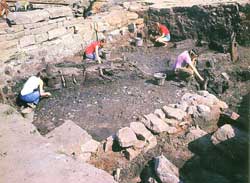|
From the Roman army's departure, to the later 19th century the
stones of the Roman fort were taken to build farms, field walls
and churches, but nevertheless is very well preserved. During the
18th and 19th centuries antiquarians interested in the history of
Hadrian's Wall first recorded the discovery of stone buildings and
inscriptions and began to conduct excavations. Modern excavation
began before the Second World War but the main programme commenced
in the 1960s and has continued ever since. The lack of overlying
modern settlement has allowed archaeologists to reconstruct one
of the most vivid impressions of a fort and its surroundings from
Britain's northern frontier.
In the late 1960s archaeologists first examined the well-preserved
stone remains of the third and fourth century Roman fort and vicus.
In 1972 the digging of a drainage ditch revealed a substantial archaeological
deposit, including organic material, beneath what had been thought
to be natural clay. Further exploration of this deposit revealed
the first writing tablet in the spring of 1973. Subsequent excavations
have revealed over 1,000 writing tablets, associated with the remnants
of five periods of timber buildings, dated between c. AD 85 and
130. The remarkable survival of the tablets is due to the anaerobic
conditions. Clay dumped to seal earlier occupation layers and level
up for rebuilding combined with the wet conditions to deny a supply
of oxygen to the bacteria that would otherwise rot organic materials.
Vindolanda is not however an easy site to excavate. Continual building
in the fort over four centuries and more has accumulated a deeply
stratified sequence of occupation. In places the remains of the
early timber forts are up to four metres below the modern ground
level. The later Roman stone buildings, preserved for display, limit
access to the earlier remains to only small areas at any one time.
Working on deeply stratified deposits is difficult in such small
areas and the plans of the early buildings are difficult to establish.
Only a small proportion of the early forts, which extend beneath
most of the later fort and vicus, has been excavated. The main hindrance
to excavation is water, both the rain and the abundant springs with
which the Vindolanda plateau is endowed. The excavator of the site
describes typical working conditions during the early excavations
after the water table was reached:
'water seeped in through the sides of the trench and bubbled up
through the floor. The working area quickly became a quagmire, every
feature and find assuming the same muddy colour… In wet weather,
when the trench became the natural drainage point for the surrounding
land, it might take the whole morning to clear the water'.

Click on the image for a larger version.
|
Image
details:
Excavations in progress on pre-Hadrianic
fort. The stone walls belong to later buildings. Timber posts
and fencing are visible, well preserved in the anaerobic conditions
Image ownership:
© Vindolanda Trust |
In these narrow trenches, always prone to waterlogging, excavation
of the tablets poses several problems. They are extremely fragile,
the consistency of saturated blotting paper when found and are highly
susceptible to damage by excavators' trowels. Once excavated, cleaning
and conservation must begin immediately: if allowed to dry, cell
collapse as well as fungal and bacterial attack would soon reduce
the tablets to dust. The archaeological context in which they are
found is also highly complex. Identifying different periods of building
in these deeply stratified deposits, has proved very difficult.
At the end of each period of occupation soldiers demolished buildings
and removed timbers for re-use. Most of the surviving deposit comprises
the highly compacted remains of bracken flooring and bedding. Building
the stone fort also damaged the remnants of the wooden buildings
beneath. Despite these problems, the excitement of the site lies
in the preservation of organic materials that would normally be
long vanished. As well as writing tablets, among the building timbers
and the bracken flooring at Vindolanda survive leather shoes, textiles,
wooden combs, dog excrement and the pupae of the stable flies
with which the fort must have been infested.
|